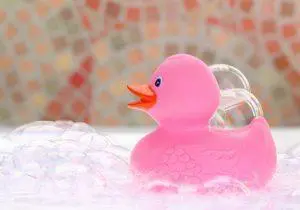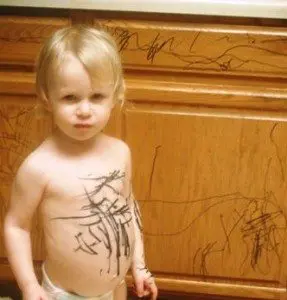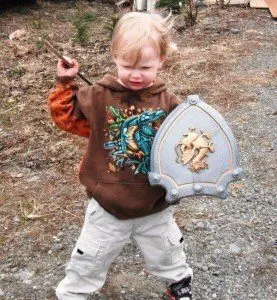I was right there in the bathroom with her. With my daughter that is. She was, for once, actually playing in the tub rather than screaming like she was being dipped in acid while I cleaned her as quickly as humanly possible. She splashed excitedly, slipped, slid, and went under the water. She was under for less than 5 seconds, but came up coughing. She seemed fine after a moment and didn’t appear to have inhaled water, but my mind immediately went to an article I’d read a few years prior about a baby who’d died after slipping underwater in the tub.
I couldn’t remember the right term, secondary drowning? Dry drowning? Delayed drowning? You can bet as soon as she was dry, clothed, and happily playing I went to researching the possible risks of a baby falling in the tub. If you find yourself in a similar situation, here’s what I learned.
The terms I was looking for were indeed dry drowning and secondary drowning (sometimes called delayed drowning). The two occur in a similar manner, but are not actually the same thing and have different timelines. Many mass hysteria click-bait pages have confused the two, and further confused realistic concerns for parents.
What is dry drowning?
Dry drowning, as far as timelines go, usually occurs just after your child has left the water. Dry drowning doesn’t actually affect the lungs directly by filling them with water. Water in the throat causes spasms which block the airway, as a result, your child can’t breathe. This is something you’re going to know about right away. Dry drowning is fairly common, but not often caused by things like bath tub slips. Swimmers, who say, cannon ball with their mouth open are the more likely victims.
What is secondary drowning?
Secondary drowning, on the other hand, usually occurs within 24 hours, but not immediately after water exposure, and is quite rare. In secondary drowning water has entered the lungs, just not so much as to cause immediate reaction. As the body attempts to remove said water, it actually creates more fluid leading to pulmonary edema (literally “lung fluid”) which then drowns the victim from the inside.
What are the symptoms secondary drowning?
Secondary drowning symptoms include:
-Cough
-Labored breathing or trouble breathing
-Feeling tired
-Chest pain
-Poor color
-Irritability
You’re basically looking for any sign that the body is not getting adequate oxygen. Obviously, if your child is showing immediate symptoms from dry drowning, you want to call 911 and get immediate care, but likewise, if your child shows signs of secondary drowning, even if not severe, you want to head to the emergency room.
Now, all that being said, I want to throw in that my baby was just fine, and I want to reiterate that secondary drowning is rare. In my opinion, it’s just a good idea to know the symptoms and keep them in mind if an accident happens and your child may have inhaled water. Rare or not though, bath tub accidents in general are very common in babies and toddlers. It’s estimated 60% of all bathtub injuries are children under 4, and in 50% of those children, injuries are to the head.
How can you prevent bathtub injuries?
-Always stay in the bathroom with kids under 4 while bathing.
-Install a non-slip mat and spout cover.
-Try to discourage standing in the tub until your child is an experienced walker (I know, easier said then done.)
Granted, you can’t bubble wrap your whole tub, and slips are bound to happen, some safety measures just, hopefully, will prevent serious injuries. If your child does fall in the tub, don’t beat yourself up, it happens, and you did what you could.



